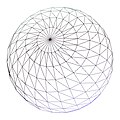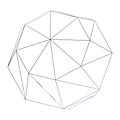Level of detail (computer graphics)
In
LOD can be decreased as the model moves away from the viewer or according to other metrics such as object importance, viewpoint-relative speed or position. LOD techniques increase the efficiency ofAlthough most of the time LOD is applied to
It is commonplace to say that "an object has been LOD-ed" when the object is simplified by the underlying LOD-ing algorithm as well as a 3D modeler manually creating LOD models.[citation needed]
Historical reference
The origin[1] of all the LOD algorithms for 3D computer graphics can be traced back to an article by James H. Clark in the October 1976 issue of Communications of the ACM. At the time, computers were monolithic and rare, and graphics were being driven by researchers. The hardware itself was completely different, both architecturally and performance-wise. As such, many differences could be observed with regard to today's algorithms but also many common points.
The original algorithm presented a much more generic approach to what will be discussed here. After introducing some available algorithms for geometry management, it is stated that most fruitful gains came from "...structuring the environments being rendered", allowing to exploit faster transformations and clipping operations.
The same environment structuring is now proposed as a way to control varying detail thus avoiding unnecessary computations, yet delivering adequate visual quality:
For example, a
visible surface algorithmsto efficiently handle.
The proposed algorithm envisions a
The significant point, however, is that in a complex environment, the amount of information presented about the various objects in the environment varies according to the fraction of the field of view occupied by those objects.
The paper then introduces clipping (not to be confused with culling although often similar), various considerations on the graphical working set and its impact on performance, interactions between the proposed algorithm and others to improve rendering speed.
Well known approaches
Although the algorithm introduced above covers a whole range of level of detail management techniques, real world applications usually employ specialized methods tailored to the information being rendered. Depending on the requirements of the situation, two main methods are used:
The first method, Discrete Levels of Detail (DLOD), involves creating multiple, discrete versions of the original geometry with decreased levels of geometric detail. At runtime, the full-detail models are substituted for the models with reduced detail as necessary. Due to the discrete nature of the levels, there may be visual
The second method, Continuous Levels of Detail (CLOD), uses a structure which contains a continuously variable spectrum of geometric detail. The structure can then be probed to smoothly choose the appropriate level of detail required for the situation. A significant advantage of this technique is the ability to locally vary the detail; for instance, the side of a large object nearer to the view may be presented in high detail, while simultaneously reducing the detail on its distant side.
In both cases, LODs are chosen based on some heuristic which is used to judge how much detail is being lost by the reduction in detail, such as by evaluation of the LOD's geometric error relative to the full-detail model. Objects are then displayed with the minimum amount of detail required to satisfy the heuristic, which is designed to minimize geometric detail as much as possible to maximize performance while maintaining an acceptable level of visual quality.
Details on discrete LOD

The basic concept of discrete LOD (DLOD) is to provide various models to represent the same object. Obtaining those models requires an external algorithm which is often non-trivial and subject of many polygon reduction techniques. Successive LOD-ing algorithms will simply assume those models are available.
DLOD algorithms are often used in performance-intensive applications with small data sets which can easily fit in memory. Although
DLOD methods are often used for "stand-alone" moving objects, possibly including complex animation methods. A different approach is used for geomipmapping,[3] a popular
A discrete LOD example
This section possibly contains original research. (September 2013) |
As a simple example, consider a sphere. A discrete LOD approach would cache a certain number of models to be used at different distances. Because the model can trivially be procedurally generated by its mathematical formulation, using a different number of sample points distributed on the surface is sufficient to generate the various models required. This pass is not a LOD-ing algorithm.
| Image | 
|

|

|

|

|
|---|---|---|---|---|---|
| Vertices | ~5500 | ~2880 | ~1580 | ~670 | 140 |
| Notes | Maximum detail, for closeups |
Minimum detail, very far objects |
To simulate a realistic transform bound scenario, an ad-hoc written application can be used. The use of simple algorithms and minimum fragment operations ensures that
OpenGL is used for rendering due to its high efficiency in managing small batches, storing each model in a display list thus avoiding communication overheads. Additional vertex load is given by applying two directional light sources ideally located infinitely far away.
The following table compares the performance of LOD aware rendering and a full detail (brute force) method.
| Brute | DLOD | Comparison | |
|---|---|---|---|
| Rendered images |

|

|

|
| Render time | 27.27 ms | 1.29 ms | 21 × reduction |
| Scene vertices | 2,328,480 | 109,440 | 21 × reduction |
Hierarchical LOD
Because hardware is geared towards large amounts of detail, rendering low polygon objects may score sub-optimal performances. HLOD avoids the problem by grouping different objects together[4]. This allows for higher efficiency as well as taking advantage of proximity considerations.
Practical applications
Video games
LOD is especially useful in 3D video games. Video game developers want to provide players with large worlds but are always constrained by hardware, frame rate and the
In GIS and 3D city modelling
LOD is found in
The analogy of "LOD-ing" in GIS is referred to as generalization.
Rendering and modeling software
- MeshLab an open source mesh processing tool that is able to accurately simplify 3D polygonal meshes.
- Polygon Cruncher a commercial software from Mootools that reduces the number of polygons of objects without changing their appearance.
- Simplygon a commercial mesh processing package for remeshing general input meshes into real-time renderable meshes.
See also
- Anisotropic filtering
- Distance fog
- Draw distance
- Mipmap
- Popping (computer graphics)
- Progressive meshes
- Sparse voxel octree
- Spatial resolution
References
- ^ "Multiple levels of detail" (PDF). clemson.edu. Retrieved 2 July 2023.
- ^ "Levels of Detail LOD" (PDF). computer-graphics.se. Retrieved 2 July 2023.
- ^ "GPU based dynamic geometry LOD – RasterGrid".
- ^ "Foliage Mode". docs.unrealengine.com. Retrieved 2 July 2023.
- ^ "Musgrave, F. Kenton, Craig E. Kolb, and Robert S. Mace. "The synthesis and rendering of eroded fractal terrains." ACM Siggraph Computer Graphics. Vol. 23. No. 3. ACM, 1989" (PDF). Retrieved 2 July 2023.
- ^ Communications of the ACM, October 1976 Volume 19 Number 10. Pages 547–554. Hierarchical Geometric Models for Visible Surface Algorithms by James H. Clark, University of California at Santa Cruz. Digitalized scan is freely available at https://web.archive.org/web/20060910212907/http://accad.osu.edu/%7Ewaynec/history/PDFs/clark-vis-surface.pdf.
- ^ Catmull E., A Subdivision Algorithm for Computer Display of Curved Surfaces. Tech. Rep. UTEC-CSc-74-133, University of Utah, Salt Lake City, Utah, Dec. 1
- ^ Ribelles, López, and Belmonte, "An Improved Discrete Level of Detail Model Through an Incremental Representation", 2010, Available at http://www3.uji.es/~ribelles/papers/2010-TPCG/tpcg10.pdf
- ^ de Boer, W.H., Fast Terrain Rendering using Geometrical Mipmapping, in flipCode featured articles, October 2000. Available at flipcode - Fast Terrain Rendering Using Geometrical MipMapping.
- ^ Carl Erikson's paper at http://www.cs.unc.edu/Research/ProjectSummaries/hlods.pdf provides a quick, yet effective overlook at HLOD mechanisms. A more involved description follows in his thesis, at https://wwwx.cs.unc.edu/~geom/papers/documents/dissertations/erikson00.pdf.
